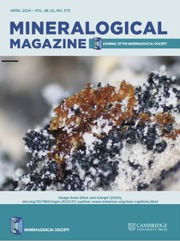Crossref Citations
This article has been cited by the following publications. This list is generated based on data provided by
Crossref.
Dawson, J. B.
and
Smith, J. V.
1988.
Metasomatised and veined upper-mantle xenoliths from Pello Hill, Tanzania: evidence for anomalously-light mantle beneath the Tanzanian sector of the East African Rift Valley.
Contributions to Mineralogy and Petrology,
Vol. 100,
Issue. 4,
p.
510.
Nawaz, Rab
and
Ryback, George
1989.
Re-examination of kirwanite: a ferri-ferro-hornblende from Co. Down, Northern Ireland.
Mineralogical Magazine,
Vol. 53,
Issue. 370,
p.
253.
Christy, Andrew G.
1989.
The effect of composition, temperature and pressure on the stability of the 1Tc and 2M polytypes of sapphirine.
Contributions to Mineralogy and Petrology,
Vol. 103,
Issue. 2,
p.
203.
Droop, G. T. R.
and
Al-Filali, I. Y.
1989.
Magmatism, deformation and high-
T
, low-
P
regional metamorphism in the Nabitah mobile belt, southern Arabian Shield
.
Geological Society, London, Special Publications,
Vol. 43,
Issue. 1,
p.
469.
Elsdon, R.
and
Todd, S. P.
1989.
A composite spessartite–appinite intrusion from Port‐na‐Blagh, County Donegal, Ireland.
Geological Journal,
Vol. 24,
Issue. 2,
p.
97.
Victor Owen, J.
and
Erdmer, Philippe
1989.
Metamorphic geology and regional geothermobarometry of a Grenvillian massif: the Long Range Inlier, Newfoundland.
Precambrian Research,
Vol. 43,
Issue. 1-2,
p.
79.
Homonnay, Z.
Kuzmann, E.
Vértes, A.
Pákozdi, A.
Kubovics, I.
Szabó, Cs.
Sólymos, G. K.
and
Jánosi, M.
1990.
Mössbauer study of amphiboles originated from the Carpathian region.
Hyperfine Interactions,
Vol. 57,
Issue. 1-4,
p.
2215.
Gallagher, S.
and
Elsdon, R.
1990.
Spinel lherzolite and other xenoliths from a dolerite dyke in southwest Donegal.
Geological Magazine,
Vol. 127,
Issue. 2,
p.
177.
Mitchell, Roger H.
1990.
A review of the compositional variation of amphiboles in alkaline plutonic complexes.
Lithos,
Vol. 26,
Issue. 1-2,
p.
135.
Castro, Antonio
de la Rosa, Jesús D.
and
Stephens, W. Edryd
1990.
Magma mixing in the subvolcanic environment: petrology of the Gerena interaction zone near Seville, Spain.
Contributions to Mineralogy and Petrology,
Vol. 106,
Issue. 1,
p.
9.
Hamilton, Roger
and
Rock, Nicholas M.S.
1990.
Geochemistry, mineralogy and petrology of a new find of ultramafic lamprophyres from Bulljah Pool, Nabberu Basin, Yilgarn Craton, Western Australia.
Lithos,
Vol. 24,
Issue. 4,
p.
275.
Rock, N. M. S.
1991.
Lamprophyres.
p.
157.
Muhling, J.R.
and
Griffin, B.J.
1991.
On recasting garnet analyses into end-member molecules—Revisited.
Computers & Geosciences,
Vol. 17,
Issue. 1,
p.
161.
Schumacher, John C.
1991.
Empirical ferric iron corrections: necessity, assumptions, and effects on selected geothermobarometers.
Mineralogical Magazine,
Vol. 55,
Issue. 378,
p.
3.
Abalos, B.
Ibarguchi, J.I.Gil
and
Eguiluz, L.
1991.
Cadomian subduction/collision and Variscan transpression in the Badajoz-Córdoba shear belt, southwest Spain.
Tectonophysics,
Vol. 199,
Issue. 1,
p.
51.
Nusbaum, Robert L.
Colgan, Mitchell W.
Lawton, Donna E.
and
Glascock, Michael D.
1991.
Mineralogic constraints on the magmatic history of Volcán Darwin flank lava at Urvina Bay, Islá Isabela, Galápagos Islands.
Journal of Volcanology and Geothermal Research,
Vol. 47,
Issue. 3-4,
p.
359.
TUBIA, J. M.
and
GIL IBARGUCHI, J. I.
1991.
Eclogites of the Ojén nappe: a record of subduction in the Alpujárride complex (Betic Cordilleras, southern Spain).
Journal of the Geological Society,
Vol. 148,
Issue. 5,
p.
801.
Gaeta, Mario
and
Mottana, Annibale
1991.
Phase relations of aenigmatite minerals in a syenitic ejectum, wonchi volcano, Ethiopia.
Mineralogical Magazine,
Vol. 55,
Issue. 381,
p.
529.
Zipfel, J.
and
W�rner, G.
1992.
Four- and five-phase peridotites from a continental rift system: evidence for upper mantle uplift and cooling at the Ross Sea margin (Antarctica).
Contributions to Mineralogy and Petrology,
Vol. 111,
Issue. 1,
p.
24.
de Bjerg, Silvia C.
Mogessie, Aberra
and
Bjerg, Ernesto
1992.
HYPER-FORM—A Hypercard® program for Macintosh® microcomputers to calculate mineral formulae from electron microprobe and wet chemical analysis.
Computers & Geosciences,
Vol. 18,
Issue. 6,
p.
717.


